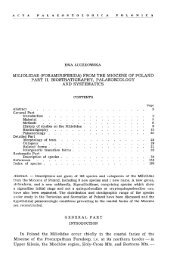Full text - Acta Palaeontologica Polonica
Full text - Acta Palaeontologica Polonica
Full text - Acta Palaeontologica Polonica
You also want an ePaper? Increase the reach of your titles
YUMPU automatically turns print PDFs into web optimized ePapers that Google loves.
CAZE ET AL.—COLOUR PATTERNS IN AMPULLINIDAE 339<br />
Fig. 6. Species of the genus Crommium Cossmann, 1888, under UV light.<br />
A. Crommium acutum (d’Orbigny, 1850), MNHN B58618 (MNHN coll.),<br />
Parnes, Oise, France, Lutetian, in ventral view. B. Crommium acutum<br />
(d’Orbigny, 1850), MNHN A30889 (MNHN coll.), Boursault, Marne,<br />
France, Lutetian, in ventral view. C. Crommium acutum (d’Orbigny, 1850),<br />
MNHN A30861 (MNHN coll.), Fleury−la−rivière, Marne, France, Lutetian,<br />
in ventral (C 1) and dorsal (C 2) views. D. Crommium grignonensis (d’Orbi−<br />
gny, 1850), type of Natica heberti Deshayes, 1864, MNHN J04185 (Hébert<br />
coll.), Chaumont−en−Vexin, Oise, France, Lutetian, in ventral view. Scale<br />
bars 10 mm. Photographs by C. Lemzaouda and P. Loubry (MNHN).<br />
der, one on the base (but often lacking) and two on the me−<br />
dian part of the whorl (Fig. 6C). The two median stripes fade<br />
with growth until they disappear. The adapical one and the<br />
basal one, when present, gradually spread on the whorl.<br />
Crommium grignonensis (d’Orbigny, 1850)<br />
Fig. 6D.<br />
Stratigraphic and geographic range.—Middle Eocene, Lute−<br />
tian (PB)<br />
Colour pattern description.—This species exhibits three lev−<br />
els of residual colouration. The background is heterogeneous<br />
with a slightly fluorescent apical part (Fig. 6D). The transi−<br />
tion between the two levels of the background is diffuse.<br />
Genus Amaurellina Bayle in Fischer, 1885<br />
Type species: Amaurellina spirata Lamarck, 1804, Grignon, Lutetian.<br />
Description.—Worldwide, this genus comprises 8 species in<br />
the Cainozoic (SOM 1). 5 of the 6 studied species (SOM 2)<br />
display the same simple organisation of residual colouration<br />
with one or several fluorescent spiral stripes on a darker<br />
background.<br />
Amaurellina spirata Lamarck, 1804<br />
Fig. 7A–C.<br />
Stratigraphic and geographic range.—Middle Eocene, Lute−<br />
tian (PB, Cotentin)<br />
Colour pattern description.—This species shows three lev−<br />
els of residual colouration. The background is heterogeneous<br />
with an almost completely dark whorl except the slightly flu−<br />
orescent shoulder that forms a spiral stripe (Fig. 7A–C). The<br />
apex is pale (Fig. 7A–C). The fluorescent stripe covering the<br />
subcarinate shoulder is straight and has a constant width (Fig.<br />
7A1, C). This stripe is sometimes also observable on the pen−<br />
ultimate whorl (Fig. 7C). The transition between this stripe<br />
and the darker colouration of the whorl is diffuse. The base of<br />
the whorl can be slightly fluorescent too.<br />
Amaurellina levesquei (d’Orbigny, 1850)<br />
Fig. 7D–F.<br />
Stratigraphic and geographic range.—Early Eocene, Ypre−<br />
sian (Cuisian) (PB)<br />
Colour pattern description.—The shells show two levels of<br />
residual colouration: a heterogeneous background with a<br />
slightly fluorescent area covering the major part of the shell<br />
(apex, spire, last whorl) except two dark “stripes”. The ada−<br />
pical one is on the median part of the whorl and is thinner than<br />
the other one located on the base of the shell (Fig. 7D, E). On a<br />
few well−preserved shells, some slightly fluorescent axial<br />
stripes are distinguishable (Fig. 7F). These axial stripes, espe−<br />
cially distinguishable on the spire, are slightly prosocline.<br />
Amaurellina sinuosa (d’Orbigny, 1850)<br />
Fig. 7G–I.<br />
Stratigraphic and geographic range.—Early Eocene, Ypre−<br />
sian (Cuisian) (PB).<br />
Colour pattern description.—The residual pattern consists<br />
of three levels of residual colouration. The background is<br />
heterogeneous with thin fluorescent spiral stripes and the<br />
apex is pale. There are two straight stripes and the adapical<br />
one is sometimes distinguishable on the penultimate whorl<br />
(Fig. 7G2, I). Both stripes have constant and similar width.<br />
Amaurellina paludiniformis (d’Orbigny, 1850)<br />
Fig. 7J–K.<br />
Stratigraphic and geographic range.—Early–Middle Eocene,<br />
Ypresian (Cuisian)–Lutetian (PB, HB).<br />
Colour pattern description.—The residual pattern consists of<br />
three levels of residual colouration. The background is dark<br />
and homogeneous, the apex is pale and there are four straight<br />
doi:10.4202/app.2009.0084
















